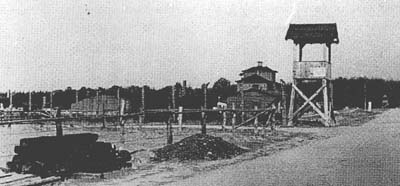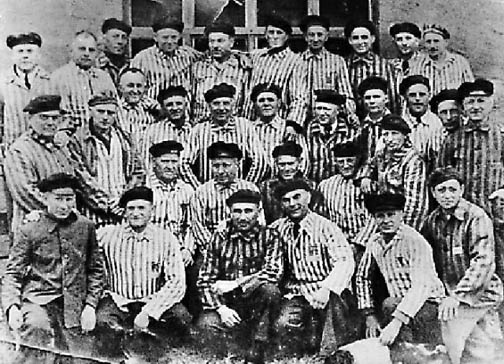Niederhagen concentration camp at Wewelsburg The smallest concentration camp in the Nazi system was KZ Niederhagen, which was set up east of the village of Wewelsburg, beginning on June 17, 1940. Before the Niederhagen concentration camp was opened, there had been a sub-camp of the Sachsenhausen concentration camp near Wewelsburg since May 1939. This was a labor camp which had been set up for the sole purpose of providing prison labor for the reconstruction of the Wewelsburg castle as an SS training school and ceremonial place for the SS. One hundred prisoners from Sachsenhausen were transferred to Niederhagen and housed in tents before 4 barracks buildings were built. The new camp was completed in September 1941 and named Niederhagen, a name which SS leader Heinrich Himmler had given to the forest surrounding the village of Wewelsburg. The camp is also known as Niederhagen-Wewelsburg. The Commandant of the camp was Hauptsturmführer Adolf Haas. The first prisoners at Niederhagen were 480 inmates from the Sachsenhausen concentration camp near Berlin. Later, the 1200 prisoners in the camp included Soviet POWs and foreign workers from conquered countries who had been transported to Germany for forced labor.  In 1943, work on the Wewelsburg castle was stopped, before it was finished, and Commandant Adolf Haas was transferred to Bergen-Belsen. Schutzhaftlagerführer Wolfgang Plaul, who was in charge of supervising the prisoners, was transferred to Buchenwald along with most of the Niederhagen inmates.  After several escape attempts by the German criminals at Niederhagen, they were replaced by Jehovah's Witnesses, called "Bible students," who were considered to be more trustworthy and not likely to escape. The Nazis called the Bible students "volunteer prisoners" because they could have been released at any time if they would only renounce their religion and join the German Army. Note that the Jehovah's Witnesses in the photo above appear to have been well treated. According to a book by Hans Hesse, entitled "Persecution and Resistance of Jehovah's Witnesses during the Nazi Regime," published in 2001, there was a total of 306 Jehovah's Witnesses sent to the Niederhagen-Wewelsburg camp and 19 of them died. Other sources say that there were 21 Jehovah's Witnesses who died in the camp. Hans Hesse attributed the low mortality rate among the Jehovah's Witnesses to group cohesiveness and their willingness to help and support each other. By way of comparison, there were 903 German prisoners in other categories at Niederhagen-Wewelsburg and at least 357 of them died, according to Hans Hesse's book. Hans Hesse wrote that the Jehovah's Witnesses were selected from prisoners at Sachsenhausen and Buchenwald for their professional skills in building construction. Although younger workers were preferred by the Nazis, 65% of the Jehovah's Witnesses at Niederhagen-Wewelsburg were over 40 years of age, according to Hesse's book. Leopold Engleitner, who is 104 years old and still alive as of July 2009, is the oldest male survivor of the Holocaust. According to an article on the Scripps Howard News Service web site, written by Michele Willer-Allred, Engleitner is a Jehovah's Witness who was 33 years old when he was given many opportunities to leave the Buchenwald concentration camp where he was being held -- if he would just renounce his faith as a Jehovah's Witness. He refused and was sent to Niederhagen and then to the Ravensbrück concentration camp. Before the start of World War II, Engleitner was living in the Austrian imperial city of Bad Ischl and was being persecuted as a Jehovah's Witness by the Nazis; in 1939, he was arrested by the Gestapo. According to the article written by Michele Willer-Allred, Engleitner was a prisoner in six concentration camps. He was eventually allowed to leave a concentration camp in July 1943 by agreeing to be a lifelong slave laborer on a farm. He escaped the farm, and fled from the Nazis in caves and mountains until the war ended. Of approximately 3,900 prisoners who were at Niederhagen between May 1939 and April 2, 1945, there are 1,285 believed to have died. All the Nazi concentration camps were used as execution sites and there were 56 persons brought to Niederhagen to be executed. After the Niederhagen camp was closed in 1943, the remaining work crew was composed of 40 Jehovah's Witnesses and two political prisoners who stayed in the village of Wewelsburg until it was liberated by U.S. troops on April 2,1945. After the war, the Niederhagen camp was used to house refugees who were survivors of the ethnic cleansing of Germans in territory that was given to Poland. The former Niederhagen camp has not been preserved. The former camp kitchen has been converted into a fire station for the volunteer fire department of Wewelsburg. The former gate house is now a two-family home, and the rest of the former camp is now a residential area with apartment houses. District MuseumCastleNorth TowerSS Generals HallSS Vault (Crypt)Witches DungeonBack to Wewelsburg indexHomeThis page was last updated on July 10, 2009 |